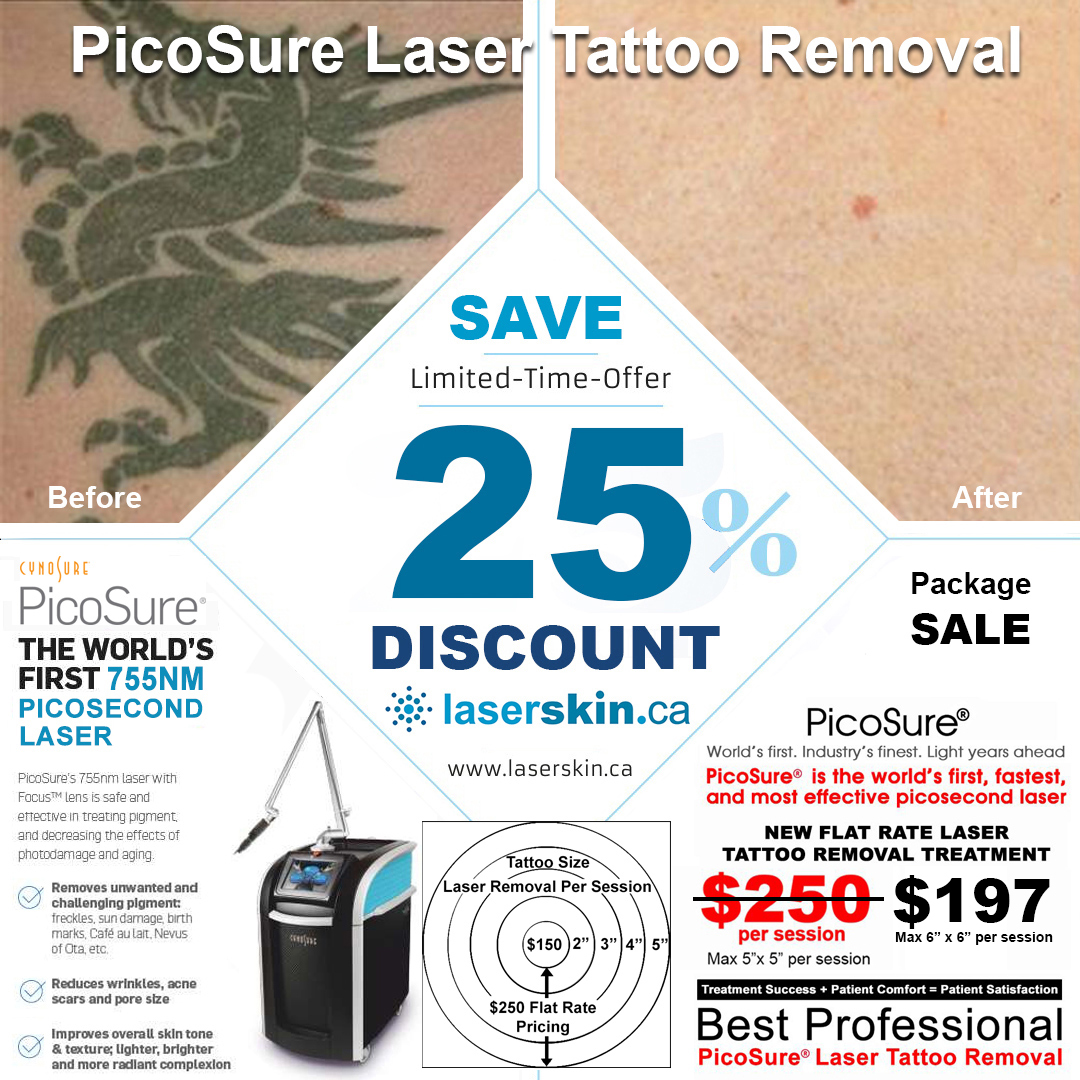
Table of Contents
Tattoo Removal Toronto
Do you need laser tattoo removal in Toronto? Our tattoo removal Toronto clinic uses the Cynosure PicoSure, the industry-leading laser for tattoo removal. The PicoSure laser was the first to employ picosecond pulse durations at wavelengths that are best for the skin to erase tattoos efficiently. With its cutting-edge technology, PicoSure produces a strong photothermal impact in a split second, reducing thermal damage to the skin while focusing energy on the chromophore for quicker elimination.
PicoSure Laser
How far tattoo removal has progressed is shown by PicoSure® technology. The picosecond 755-nm alexandrite laser is a safe and effective tattoo removal method in several academic and clinical studies.
PicoSure’s cutting-edge technology produces a powerful photothermal impact in trillionths of a second, sparing the skin from significant+ thermal damage and focusing on the chromophore for more excellent removal in fewer sessions.
The tattoo removal procedure is simplified with PicoSure. While “sunset colours” (red, yellow, and orange) may be efficiently treated with the alternative 532nm wavelength, black, blue, and green tattoo inks can be effectively treated with the 755nm wavelength. Additionally, you’ll be able to:
- Customize treatments by utilizing different spot sizes
- It uses 532 nm, 755 nm, and 1064 nm for treatment; it treats tough tattoos more successfully with shorter pulse width and boost mode.
- To cure black ink in those with darker skin types, use 1064 nm delivery.
- Tattoo Removal Using Q-Switched Lasers
- A method for producing a pulsed laser beam is known as Q-switching, Q-spoiling, or Q-switch laser. These developments make it possible to create light pulses with previously unheard-of peak powers. The ink pigment is broken into pieces by Q-Switch lasers employing intense light bursts. Q-Switch lasers work in nanoseconds as opposed to the more recent picosecond lasers, which have evolved into the industry standard for laser tattoo removal.
- An ultrafast laser
- The Picosure laser from Cynosure was the first to be suggested for treating benign pigmented lesions and tattoos when it was launched in 2013. A significant turning point in laser technology was the creation of the picosecond laser, which has already revolutionized various laser therapies.
- According to Cynosure, PicoSure is the leading picosecond aesthetic laser in the world. Because it is now the fastest and most pleasant technology available, it has made the most advancements in the laser tattoo removal industry.
- Dr. Roy Geronemus, head of the New York Laser and Skin Surgery Center, investigated picoSure. He discovered that applying PicoSure to tattoos with many colours resulted in over 80% complete eradication. In addition, Dr. Geronemus claims that the PicoSure laser’s short pulse duration efficiently removes tattoo pigment, leading to higher patient satisfaction and superior results to current Q-switched technology.
Why do people get tattoos?
The process of tattooing creates permanent markings on the skin, and the process of tattoo removal is the removing these markings from the skin. Since the dawn of man, people have put permanent markings on their skin using inks, dyes, and pigments into the dermis layer of their skin. They use different processes and techniques, from hand-tapping traditional tattoos to modern tattoo devices. Call our Tattoo Removal Toronto or Richmond Hill clinic if you would like to get a free consultation on your tattoo removal.
The types of tattoos people put on their bodies range from decorative with no specific meaning to symbolic tattoos with a purpose to the person. They could be pictorial that depicts a person, animal, or item. Many tattoos depict pledges of love with a person’s name, symbols of religious or spiritual devotion, rites of passage, bravery, marks of status, or forms of punishment on slaves, prisoners, and convicts.
Tattoo regret – why do people remove their tattoos?
There are many reasons people want to remove their tattoos. However, these are the most common ones:
- Taste has changed – as people get older, what they liked when they were younger is no longer necessary in their lives.
- Poor quality tattoo – a person may want a good quality tattoo but end up with a blotched tattoo that they don’t like
- Social Perception – as times change, tattoos that were once socially acceptable may become unpopular or distasteful.
- Family – when you were younger, you didn’t think about having a family and having your kids ask about your tattoos of the past.
- Breakup – People in love often tattoo their sweethearts’ names as a symbol of their love. Unfortunately, separations occur, and you no longer want their name or image on you.
- Job requirements – depending on your employment, some employers do not want their staff to show off their tattoos.
- Want something new – some people be tired of looking at the same tattoo they’ve had for years and want to update them with something new and fresh.
Types of tattoo removal used in Toronto
Tattoo removal falls into two categories, non-laser and laser tattoo removal.
Before the invention of laser tattoo removal, people had to settle for other methods. Here are the most popular non-laser tattoo removal methods.
People had to make do with various tattoo removal procedures before discovering laser tattoo removal. The following are the most common non-laser tattoo removal procedures.
Tattoo removal with saline
Saline tattoo removal removes or lightens tattoos using a saline solution. The procedure entails tearing the skin to access the tattoo ink and using a saline solution to remove the ink from the skin. The saline breaks apart the pigment in the skin and begins to pull the stain out by osmosis. After the procedure, a scab develops, and the colouring is gradually drawn to the surface; when the scab comes off, part of the pigment will fall off, leaving a lighter tattoo. Recently, a tattoo machine has been utilized to split the skin to get the tattoo ink.
Tattoo removal with dermabrasion
Dermabrasion tattoo removal is a surgical treatment in which the outer skin layers are removed using a medical grinding instrument. The goal is to remove the layers of skin containing the ink particles, erasing the tattoo. Because this operation is uncomfortable, a numbing cream is utilized throughout the surgery. The open wound closes, and a scab forms. This procedure, which may result in substantial scarring, should only be carried out by persons with extensive training in this method.
Tattoo removal surgery
Surgical tattoo removal is removing the tattoo using a knife and then sewing it back together. The method may erase the tattoo in a single session; however, the scar caused by the incision and stitches is a disadvantage.
Tattoo removal using a chemical peel
A chemical peel tattoo removal procedure includes applying trichloroacetic acid (TCA) to the tattoo to remove the outer layer of skin and, with it, the tattoo ink. TCA will leave an open wound that must be treated after the treatment. In around 5-7 days, a scab will develop.
Creams for Tattoo Removal
Tattoo removal lotions are widely available. The goal is to apply the cream on the tattoo, hoping it will disappear. Tattoo creams, unfortunately, do not work. Tattoo creams often include glycolic acid, trichloroacetic acid (TCA), and hydroquinone. Unlike the pure TCA stated above, these lotions exfoliate the skin’s surface (the epidermis). However, since your tattoo is placed in the second layer of your skin (dermis), the cream is ineffective in reaching this layer.
Tattoo removal via cryosurgery
Tattoo removal using cryosurgery includes freezing your skin with liquid nitrogen and sanding the skin layers away. This treatment is unpleasant and necessitates the use of a local anesthetic. In addition, this form of tattoo removal might result in scars, blisters, infections, and scabbing.
Tattoo Vanish – Everything is natural.
Toxins, acids, lasers, and other toxic substances are used in various tattoo removal treatments. However, Tattoo Vanish is entirely natural. This tattoo removal process is incredibly successful, and since it does not utilize a laser, it considerably reduces the hazards connected with it.
Tattoo Vanish completes the task with fewer treatments.
Many people believe that laser tattoo removal is the most successful technology available today, yet it has some drawbacks. One of the most significant disadvantages of laser tattoo removal is the number of sessions required to achieve results. Some people pay for and undergo ten sessions, only to be left with a tattoo that has faded but is not gone. Tattoo Vanish may remove tattoos in half the number of sessions required by laser tattoo removal – up to 75% fewer sessions!
The Tattoo Vanish Method is less expensive.
You may purchase a tattoo removal cream cheaper than the Tattoo Vanish Method online, but these creams do not work. When it comes to successful tattoo removal treatments, the only competition for Tattoo Vanish is laser tattoo removal, which may be expensive. Tattoo Vanish is less costly than laser tattoo removal. Furthermore, since it works in fewer sessions, it is simple to understand how it may help you save more money.
Tattoo Removal Toronto – The benefits of laser tattoo removal
- Demand for tattoo removal has increased as tattoos have become more popular. Laser tattoo removal has become a more popular procedure.
- Twenty-eight people used an argon laser to erase their tattoos in 1979, with mixed results partly.
- A recent clinical study in Scotland in the 1980s looked at the impact of Q-switched ruby laser light on blue/black tattoos. However, success rates for further studies with tattoos in various colours are variable.
- Numerous microscopic pigment particles are left behind when an ink tattoo is created by injecting ink into the dermis. These particles heat up and fracture into smaller pieces due to the photomechanical effects of laser therapy. In addition, macrophages often carry tattoo ink particles to lymph nodes close to the tattoo. Immune cells called macrophages specialize in removing foreign substances from the body by encasing them in a protective cellular envelope and expelling them from the tissue.
- The ink particles quickly absorb the energy as part of the photomechanical process. The following four factors affect whether laser tattoo removal is effective in removing tattoo pigments:
- The tattoo pigment must absorb the laser light more quickly than the surrounding skin. As a result, different laser wavelengths are required for different tattoo colours. To provide an example, yellow pigments don’t consume much light, but green tattoo colours prefer to absorb red light.
- Each laser pulse must have enough energy to heat the pigment to the point where it separates, and a very short laser pulse must give it.
Several lasers may be used to remove inks of different colours.
- Q-switched 694 nm for ruby. Green and dark tattoo colours absorb the red light that is emitted by this laser.
- Q-switched, The wavelength for alexandrite is 755 nm. Red, orange, yellow, brown, and other colours do not work well with this laser because it absorbs green pigment. Another model claims to erase ink more effectively and runs at picosecond speeds.
- Q-switched Double-frequency Nd: YAG: 532 nm. The green light from the laser is absorbed by the red, yellow, and orange pigments.
- It works better on darker skin tones than the ruby since its light is not absorbed by melanin. The picosecond laser is better at eradicating black ink from tattoos than the nanosecond laser because its pulse width is substantially shorter. In contrast to Q-switched tattoos, the difference with polychromic tattoos is minimal.
How many laser treatments are necessary to have a tattoo removed?
The likelihood of success and the required number of laser tattoo removal sessions are often determined using the Kirby-Desai scale. Unfortunately, patients often participate in the procedure without being fully informed of the likelihood of success and frequently get a poorly defined estimate of the number of treatments. Six characteristics are given numerical values in the Kirby-Desai scale: skin type, location, colour, ink quantity, scarring or tissue alteration, and layering.
The average number of laser tattoo removal sessions needed was 8, ranging from 3 to 20 sessions. Six weeks must pass between treatments.
Skin tone: Fitzpatrick scale patients with darker skin are not good candidates for laser tattoo removal. In addition, as a result of utilizing the laser on lower settings to minimize undesirable side effects like hypopigmentation, they often need longer wait periods between treatments.
Set up a free consultation today
Are you looking for Toronto laser tattoo removal? You want to have a tattoo removed. Why don’t you fill out our online form, submit a few pictures of your tattoo, and we’ll get back to you with the price and any questions you may have straight away? We provide our non-laser tattoo removal procedures in Mississauga, Richmond Hill, and Toronto, as well as our laser tattoo removal technique at our Richmond Hill site. CLICK HERE



